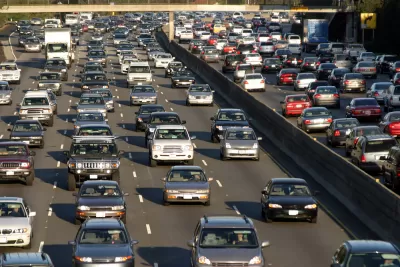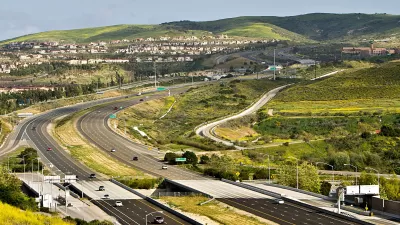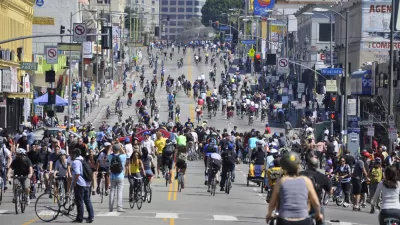Two powerful governmental bodies that deal with very different aspects of transportation—one with meeting mobility needs, the other with its impact on health and the environment—met formally for the first time on June 27.

"A historic first meeting this week between the California Air Resources Board (ARB) and the California Transportation Commission (CTC), required by [Assembly Bill 179 (2017) by Assemblymember Sabrina Cervantes (D-Corona)], produced no formal action plans," reported Melanie Curry, editor of Streetsblog California, on June 29. "But it did demonstrate the disconnect between the perspectives of the two groups, who hold decision-making power over California’s transportation systems."
The CTC oversees the spending of state transportation funds while the Air Resources Board deals with the emissions created by fossil-fuel powered transportation, among other sources. One area of overlap is regional transportation planning that was transformed by the passage of SB 375 in 2008. "Each of California's metropolitan planning organizations (MPOs) must prepare a 'sustainable communities strategy' (SCS) as an integral part of its regional transportation plan (RTP)," according to ARB.
ARB is preparing a report for the legislature, required by Senate Bill 150 (2017) by Sen. Ben Allen ((D-Redondo Beach), "that discusses regional changes in greenhouse gas (GHG) emissions, as well as best practices and challenges to achieve greater reductions under SB 375," according to ARB's notice [pdf] announcing four workshops to solicit input.
"The results so far are not good—while California has experienced a slight decline in driving, it is nowhere near enough to reach the state’s 2020 goals, let alone stricter goals beyond that date," adds Curry. See ARB graph via Streetsblog of increasing vehicle miles traveled and GHGs.
Recent reports and articles have focused on the dichotomy of increasing emissions from transportation while emissions from others sectors are decreasing, particularly after ARB released in June 2017 its most recent greenhouse gas emissions inventory report.
The ARB–CTC meeting was important because it made transportation commissioners aware that their spending decisions were part of the problem, and that SB 375 has not been working as intended.
And early data also shows that the creation of the SCSs did not change transportation funding patterns at all. That is, overall local and state spending on roads and highways is about the same as it was before California decided it needed to shift transportation funding towards to more sustainable and healthy modes such as transit and active transportation.
[T]hese early findings underscore the need for, and the importance of, this week’s historic joint meeting: The environmental and climate goals California is trying to reach are being undermined by the way transportation investments are made.
Curry goes on to describe the interactions between the members of the two groups, along with providing numerous links to helpful data by ARB staff pointing to the need to reduce vehicle miles traveled. For example:
At this meeting, members of the two groups seemed to talk at cross-purposes. Commissioners focused on economic concerns, while board members repeatedly reminded everyone that health outcomes were just as important.
A final, disappointing observation made by the Streetsblog editor that speaks well of the non-profit transportation news site:
There didn’t seem to be any reporters present, save for this one, and there hasn’t been any news coverage of the meeting. People don’t seem to understand the significance, let alone the urgency, of bringing together and coordinating different state goals under one roof.
Hat tip to Jim Stewart.
FULL STORY: Californians Must Drive Less, Says ARB at Historic First Joint Meeting with CTC

Alabama: Trump Terminates Settlements for Black Communities Harmed By Raw Sewage
Trump deemed the landmark civil rights agreement “illegal DEI and environmental justice policy.”

Study: Maui’s Plan to Convert Vacation Rentals to Long-Term Housing Could Cause Nearly $1 Billion Economic Loss
The plan would reduce visitor accommodation by 25% resulting in 1,900 jobs lost.

Planetizen Federal Action Tracker
A weekly monitor of how Trump’s orders and actions are impacting planners and planning in America.

Wind Energy on the Rise Despite Federal Policy Reversal
The Trump administration is revoking federal support for renewable energy, but demand for new projects continues unabated.

Passengers Flock to Caltrain After Electrification
The new electric trains are running faster and more reliably, leading to strong ridership growth on the Bay Area rail system.

Texas Churches Rally Behind ‘Yes in God’s Back Yard’ Legislation
Religious leaders want the state to reduce zoning regulations to streamline leasing church-owned land to housing developers.
Urban Design for Planners 1: Software Tools
This six-course series explores essential urban design concepts using open source software and equips planners with the tools they need to participate fully in the urban design process.
Planning for Universal Design
Learn the tools for implementing Universal Design in planning regulations.
Caltrans
Smith Gee Studio
Institute for Housing and Urban Development Studies (IHS)
City of Grandview
Harvard GSD Executive Education
Toledo-Lucas County Plan Commissions
Salt Lake City
NYU Wagner Graduate School of Public Service





























